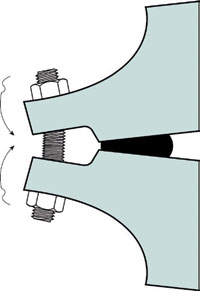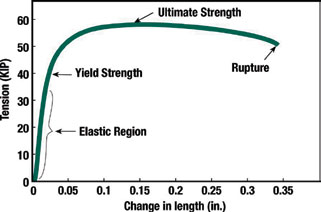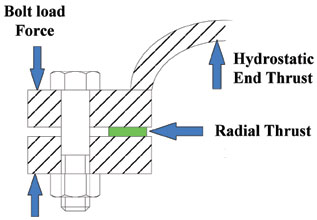Typical operating environments create unique challenges for plant maintenance personnel when meeting their goals of reliably sealing bolted flange connections.
Many factors can prove detrimental to the performance of a gasket used to seal flanges—including flange alignment and flange imperfections, vibration, pressure and temperature surges, chemical attack, gasket creep, changes in clamping force and improper gasket loading. An understanding of bolted flange connections is critical to ensure optimum gasket performance and improve flange sealing reliability.
Bolted Flange Connections
A flange is a method of connecting pipes, valves, pumps and other equipment to form a system. A bolted flanged connection versus a welded connection provides easy access for cleaning, inspection and modification of a piping system. Flange joints are made by bolting two flanges together with a gasket between them to form a seal.
Many types of bolted flange connections have been designed for different equipment—including ANSI/DIN pipe flanges, valve bonnets, site gages, manways, handholes and heat exchangers. An ideal flanged joint would consist of two, mirror-finish, perfectly flat and parallel surfaces bolted directly together to create a leak-free seal. However, manufacturing processes do not allow for perfect sealing surfaces. Most flange faces have surface irregularities that cannot be sealed without the use of some type of compressible, resilient material or a combination of materials between them to seal the fluid being transferred. Therefore, a gasket is used between these surfaces to compensate for real world conditions.
The flange faces are the effective sealing areas of the flange. A gasket is placed between the flange faces, and they are mated together when the flange is bolted and the gasket is compressed between them.
Bolted flange joint leaks have been a cause for concern across all industries—including chemical, hydrocarbon processing, power and pulp and paper. While advancements have been made —such as gasket design, materials and bolting—the high-temperature, high-pressure applications continue to create a sealing challenge.
Flange leakage can be gradual, sudden or drastic. Visible flange leakage is recognizable and leads to costs associated with loss of fluid. In addition, fluid leakage can result in environmental and safety concerns. Even though individual flange leaks may not be considered to have large leakages, so many flanges are used throughout a plant that they do contribute to overall leakage. An average plant may have from 3,000 to 30,000 flanged components to be monitored, and large facilities may have more than 100,000 components, with different standards applied for monitoring and compliance with environmental regulations.
In some industries, non-visible leakage can also be a concern such as fugitive emissions from Volatile Organic Compounds (VOCs) and Volatile Hazardous Air Pollutants (VHAPS). Leak Detection and Repair (LDAR) is a program implemented to comply with environmental regulations for reducing the leakage of targeted fluids into the environment. Process components subject to LDAR are often monitored to detect VOC and VHAP leaks, which are required to be repaired within a predefined time period. Enforcement Consent Decrees and LDAR monitoring programs can result in significant fines for non-compliance.
Proper Selection and Techniques
Some important items to consider in flange sealing are selecting the right gasket and applying the correct load.
Selecting the Proper Gasket
To ensure that an application is sealed properly, the first step is to choose the right gasket.
When selecting a gasket there are many factors to consider including:
- Chemical compatibility
- Temperature resistance
- Pressure capability
- Compressibility
- Recovery
- Thickness
- Temperature cycling
- Flange condition
- Flange vibration
These factors are all related. Many times, a change in one parameter can affect another so all need to be considered to determine the best gasket for the application.
Proper Bolting Techniques
Proper bolting practices are important to ensure the gasket gets the proper sealing stress. The primary factors affecting gasket loading from bolting are:
Thread Friction—lubrication of bolts is necessary to reduce excess thread friction and maintain a consistent coefficient of friction during assembly. Proper lubrication of all thread contact areas, nut faces and washers with an anti-seize lubricant will help ensure that the torque applied to the flange bolts yields as accurate and consistent a gasket stress as possible.
Bolting Sequence—proper bolting sequences must be followed to ensure even loading of the gasket.
Tightening Method — the installation and torquing procedures are important to the reliability and operational safety of flanges. Assuring a correct sealing force is applied and maintained will help avoid problems with flanges. Use of a torque wrench, hydraulic tensioning equipment or stretch control to apply the recommended sealing force is critical to establish bolt loads and gasket seating stress above the minimum required to maintain a seal.
Often selecting the right gasket and using proper bolting techniques will be enough to ensure flange reliability. However, some flanges such as critical and problematic flanges can benefit from an engineering analysis.
Engineered Flange Sealing System
Optimizing Gasket Sealing Stress
Improving flange reliability requires the understanding of why the bolted connection failed. Critical and difficult flange applications at a plant often need a more detailed understanding and analysis of the flanged joint. Heat exchangers are often critical problematic applications due to thermal variations and hydrostatic pressures. See Figure 1. An engineered flange sealing system takes into consideration proper gasket sealing stress and optimized bolt loading.

Figure 1. Typical Heat Exchanger
Improper gasket load is one of the leading reasons for gasket failures in plants. The ASME Boiler & Pressure Vessel Code establishes code for flange design and discusses m & y factors. The gasket must conform to the flange surface and must be compressed enough to seal any voids and prevent leaks. This stress referred to as the minimum gasket seating stress (psi, MPa) is the Yield “y” value. The “m” maintenance value is used to determine the compressive load on the gasket to maintain a seal when the vessel is pressurized. However, these m and y values have limitations and can not be used solely to ensure a leak-free flanged joint. While m & y factors are important, a complete analysis of the entire assembly needs to be completed to ensure flanged joint reliability.
Too little applied stress results in excessive leakage; too much applied stress can result in gasket creep and irreversible damage to the gasket and excessive flange and/or bolting deformation. See Figure 2.

Figure 2. Flange Rotation as a result of overloading.
Gaskets perform the sealing in flanges, but the flange bolts provide the gasket stress necessary to achieve an effective seal. A bolt is an elastic element. When it is tightened it will stretch. When the bolt is stretched in its elastic region it will retain its memory. As a result, when the bolt is stretched it will exert a force on the flange and the gasket as it tries to get back to its original length. The more you stretch it in its elastic region, the higher the bolt force transferred to the flange. The stretch of the bolt is limited by the yield strength. It is important that the bolt stress is within its elastic limits. If the bolt is stressed beyond its yield point, it will no longer provide the required elasticity for the flanged joint to seal reliably. See Figure 3.

Figure 3. Typical Elastic Curve for a Bolt.
A correct and constant bolt load is essential to reach and maintain the proper compression of a gasket throughout its service life.
The seal is affected by the action of force on the gasket surface. Sufficient stress/load must remain on the gasket surface to prevent leakage. Hydrostatic end thrust works to open the flange joint and reduces gasket seating stress. See Figure 3. The bolt load force must be greater than the force created by system pressure to maintain the seating stress on the gasket above the minimum required to maintain a seal.

Figure 4. Hydrostatic End Thrust.
Many problem flanges are subject to thermal expansion and contraction, pressure surges and vibration. These factors can either decrease or increase the bolt load and gasket stress from the initial installed values, which can lead to premature leakage and failure of bolted assemblies. Flanges can be a dynamic component and often require a dynamic sealing solution to be properly sealed.
Maintaining Gasket Sealing Stress
An engineered flange sealing system provides a complete engineered solution focused on fluid compatibility, pressure and temperature and maintaining the proper seating stress of bolted joints through temperature cycling and mechanical distortion due to vibration. All these dynamics are considered to recommend the best flange sealing solution, and where applicable will incorporate flange live loading engineered specifically for the flange. Upon engineering analysis Flange Live Loading often provides the necessary increased margin of safety and reliability for these applications when used in conjunction with the optimal gasket and bolt loading.
Flange live loading uses specially designed flange discs to replace washers under the bolt nuts and increases the original bolt stretch. The typical engineered live loading system will provide approximately six to eight times the stored energy through the use of flange discs to maintain a load on the sealing system when compared to standard bolting. The live loading system allows stored energy to automatically adjust to system fluctuations and maintain enhanced pressure on the gasket.
The use of flange live loading can help maintain proper gasket stress through thermal cycling by storing elastic energy. Stored elastic energy minimizes the loss of bolt stress resulting in a longer life.
For difficult flange sealing applications, an engineered Flange Sealing System will:
- Maintain a uniform clamping force, improving bolted joint sealing reliability
- Compensate for thermal expansion and contraction
- Absorb vibration shock
- Dampen the effects of pressure surges, preventing gasket blowouts
- Provide a cost effective solution for expensive leakage and maintenance on critical equipment
Plant personnel working together with a supplier who has the engineering expertise, tools and resources to evaluate flange sealing needs can properly implement an engineered flange sealing reliability program designed to improve MTBR, lower leakage and reduce total maintenance and operating costs.
Pumps & Systems, September 2010


